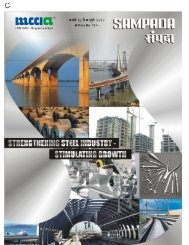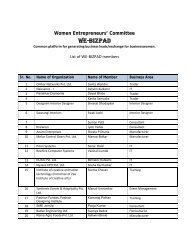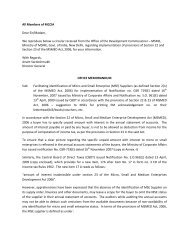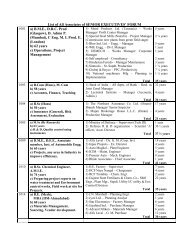read more... - Mahratta Chamber of Commerce Industries ...
read more... - Mahratta Chamber of Commerce Industries ...
read more... - Mahratta Chamber of Commerce Industries ...
Create successful ePaper yourself
Turn your PDF publications into a flip-book with our unique Google optimized e-Paper software.
Unfortunately the sharp focus on these considerations has fallen by the wayside, as India has been gripped by crony<br />
capitalism, divisive politics, and back door regulations. Today populism inhibits sound decision making on the part <strong>of</strong> the<br />
government. Schemes meant ostensibly for the betterment <strong>of</strong> the masses - like the MNREGA, The Indira Awaas Yojana,<br />
etc. have degenerated - to an extent that the huge burden <strong>of</strong> expenditure on the government is made worse by large<br />
amount <strong>of</strong> leakage. It has been impossible for the powers that be, to exorcize the ghost <strong>of</strong> socialist era interference in<br />
economic decision making. Entrenched bureaucracy is unwilling to allow economic power to be regulated by market<br />
forces, and by truly independent regulatory bodies.<br />
The need <strong>of</strong> the hour is to speedily install supply side reforms, to ensure strong economic growth.<br />
a) Fiscal reforms - particularly introduction <strong>of</strong> GST. The second wave <strong>of</strong> reform, at state level regulation - relating to<br />
taxes, land acquisition, transport, farm economy, etc. are not emphasised, barring exceptions.<br />
b) Labour reforms - to focus on increase in skill development opportunities, increase in employment opportunities,<br />
rather than socialist era protection to only those who are al<strong>read</strong>y unionised, at the cost <strong>of</strong> millions who are unemployed<br />
/ unorganised. The entire unionised workforce <strong>of</strong> India is less than 1 per cent <strong>of</strong> population.<br />
c) Infrastructure development. Similar to the national highways, new funds need to be created for various infrastructure<br />
activities at state levels. It is important to prevent diversion <strong>of</strong> tax revenues into populist measures (which politicians<br />
are <strong>more</strong> interested in, for quick political gains), than to put into assets which enhance employment potential and<br />
productivity.<br />
This is a tall order, it calls for consensus by the ruling polity <strong>of</strong> India, on both policy and on governance. The steadily<br />
escalating bitterness in the debate on governance, on transparency, on accountability, as seen in the Lokpal<br />
movement - does not auger well for creating a sound consensus. India's problem is “governance”, above all. A<br />
historic opportunity for economic growth is in danger being compromised, due to policy paralysis and parochial<br />
priorities.<br />
Trade and commerce, in terms <strong>of</strong> wholesale and retail business in commodities, in consumer goods including durables<br />
and non-durables, in automobiles and farm inputs - has seen growth year on year, due to the opening up and greater<br />
gradual integration <strong>of</strong> the rural economy <strong>of</strong> India into the mainstream. Policy measures to remove the debt burden <strong>of</strong><br />
farmers has had a significant beneficial effect in this regard. The modern farmer has become a creditworthy entity. Yet<br />
investments in infrastructure for agriculture are woefully short. India has improved its food stocks, only to find abysmal<br />
storage capacities and horrific waste. Investment in management <strong>of</strong> the food chain, simplification <strong>of</strong> the supply chain<br />
from farmer to the consuming citizens, speeding up the logistics and improving the phyto sanitary conditions in this<br />
regard, has to be a priority. This is a very significant area <strong>of</strong> opportunity for business, for industry and <strong>of</strong> course very<br />
important for the country's economy. Multi-brand FDI in retail, if relevant, has to be seen in this light.<br />
Policy correction in regard to agricultural produce support needs a relook. Milk, pulses, egg, vegetables need to spurt in<br />
output. It is these items which contribute to inflation in prices, and not cereals. That the demand for non-cereal<br />
component <strong>of</strong> food is rising indicates that the standard <strong>of</strong> living is rising. This is wonderful – but needs a policy response<br />
to sustain.<br />
At the current rate <strong>of</strong> growth <strong>of</strong> around 6 per cent per annum in GDP, actually speaking India is standing still. China is<br />
growing at over 10 per cent per annum, the gap between the Indian and the Chinese economy in the last twenty years has<br />
increased rather than decreased. India today is 40 years behind China. China consumes 450 kilos <strong>of</strong> steel per person per<br />
year, the West (Europe and USA) consume 400 kg per person per year, whereas India consumes 40 kg. China lays 40<br />
kilometers <strong>of</strong> roads per day, India lays 10 kilometres per day. This clearly shows that we need to focus on economic<br />
achievements, rather than on parochial or emotive political issues.<br />
Water availability for agriculture is still a constraint, in spite <strong>of</strong> significant improvement in water conservation through<br />
dams, percolation tanks, irrigation canals, etc. The use <strong>of</strong> water in India is extremely wasteful. We pride ourselves on<br />
export <strong>of</strong> rice, without consciously knowing that each kilo <strong>of</strong> rice that we export consumes 4000 litres <strong>of</strong> water to<br />
produce. Crop selection therefore is as important, as active measures for water conservation.<br />
India stands at an important juncture. The next few years will show whether this, once in a few hundred years opportunity,<br />
is handled wisely by India or not.<br />
On the state <strong>of</strong> Maharashtra's economic scenario, a number <strong>of</strong> major concerns remain. Maharashtra has had the proud<br />
privilege <strong>of</strong> being the most respected state for the achievement <strong>of</strong> its industrial and business communities. Yet, the<br />
growth <strong>of</strong> existing industries in Maharashtra, and the establishment <strong>of</strong> new industries in Maharashtra, now increasingly<br />
face a number <strong>of</strong> constraints.<br />
1) Land availability and price are very adverse. The FSI for industries in MIDC areas is one (100 %), whereas in non-MIDC<br />
areas, it varies between 10 to 15 per cent.<br />
Considering the improving infrastructure in cities and towns where MIDCs exist, the FSI within MIDC areas should be<br />
raised from 1 to 2, and in non-MIDC areas should be raised to 1 on a blanket basis. This will reduce the cost <strong>of</strong><br />
setting up or growing industries. It will conserve agricultural land. It will improve industrial productivity, with<br />
the beneficial effect on cost, and will counter-act the pressure on industries from high levels <strong>of</strong> taxation.<br />
Above all it will help sustain the attraction <strong>of</strong> industries to Maharashtra – it can be achieved at no cost.<br />
2) In several municipal corporations in Maharashtra we still have to live with the obnoxious, the<br />
outdated and the most controversial tax - octroi. Not only octroi collection leads to high cost for<br />
3
















